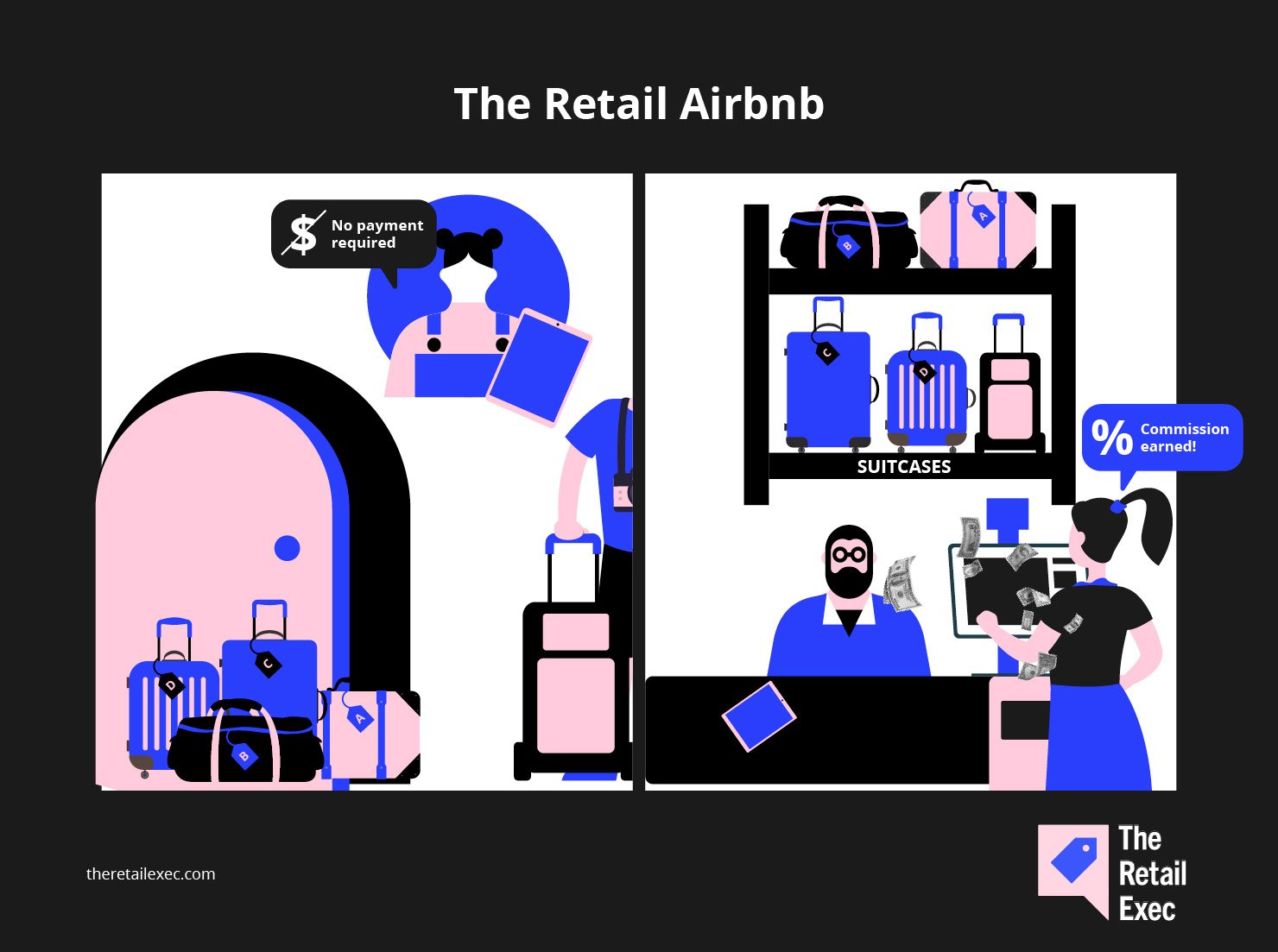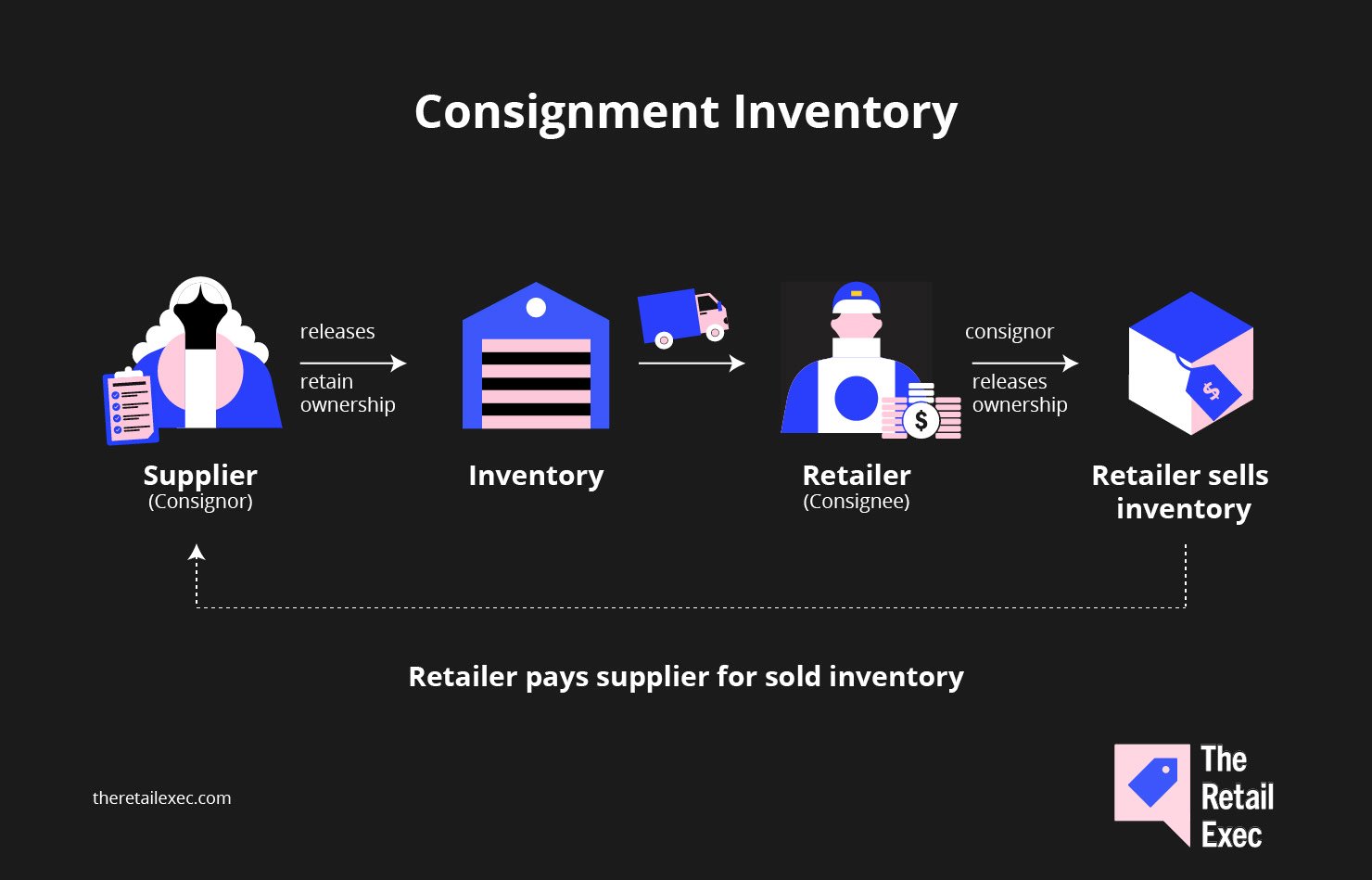You buy stuff your business doesn’t even own, and you hustle to sell it before it loses value.
What could go wrong, eh?

A fire in an upper apartment caused by a space heater damaged about $170,000 of inventory at a Harford County consignment shop on Friday, February 14, 2025.
“People don't realize that each one of these items is owned by somebody else,” said Jarod Thurston, who owns Olivia's Shop. “It's almost like a total loss. Right now, I have no idea how we're going to pay them.”
Now that’s the dark side of consignment inventory.
But when done right? You get serious benefits.
Ben Read, CEO of Mercha, improved cash flow by 18% for his business because they were able to focus on scaling operations instead of tying up funds in unsold inventory.
And Ben isn’t the only retailer who’s had luck with consigned goods.
Let’s break it down.
What is Consignment Inventory?
Consignment inventory is retail's version of “try before you buy.”
Suppliers drop their stuff at your place but keep owning it. You don't fork over cash until some customer actually buys it—a world away from when you purchase inventory upfront and tie up capital.

📦 Think of it like this:
You’re running a retail Airbnb. Your suppliers are the guests. They leave their products with you, and you take a cut when someone checks out with them.
The benefits of consignment inventory
You don’t just reduce financial risk. You gain flexibility.
For you (the retailer):
- Keep your cash. Less money tied up in stock = more money for literally anything else. Marketing. Staff. That fancy espresso machine.
- Spice up your shelves. Test new products, weird niche stuff, or pricey items without the financial hangover if they don't move.
- Dodge the discount bullet. Less pressure to slash prices on aging stock just to recoup some cost, because it wasn't your cost initially.
- Better supplier relationships. You're both working towards the same goal: selling the stuff. This often leads to actual partnerships, not just transactions.
Take it from Matt Little, owner and managing director at Festoon House:
The biggest advantage is market access.
Consignment lets you get your product in front of customers you might not reach otherwise, particularly with retailers who are hesitant to commit to a large upfront purchase.
I asked him: Does a particular example come to mind?
Early on, a well-known garden center chain was unwilling to purchase our lights outright due to their premium price point.
Offering consignment allowed us to showcase our lights in their high-traffic locations, and once customers saw the quality and aesthetic, sales took off.
For them (the supplier):
- New playground. They get their products in front of your customers without building their own costly sales channels. Win-win.
- More eyeballs, more sales. Your store/website is another place for their brand to shine and make money.
- Piggyback marketing. They benefit from your foot traffic, website visitors, and marketing campaigns.
- Closer to customers. Sometimes, having inventory sitting in your local warehouse is strategically smart for them.
How Does Consignment Inventory Management Work?
Here’s how the process usually plays out:
- Paperwork time. You and the supplier hash out a deal. Who gets what money? When? What happens when stuff breaks? Get it in writing.
- Delivery day. The supplier dumps their precious cargo at your doorstep. You sign for it. No money changes hands.
- Make it pretty. You stick their stuff on your shelves, maybe next to things you actually paid for. Customers can't tell the difference. That's the point.
- Cha-ching. Someone buys a consigned doohickey! You pocket the full payment from the happy customer. Then, when the agreed-upon payday rolls around (maybe every two weeks, maybe monthly), you send the supplier their cut. Keep yours. Everyone's happy. (Theoretically.)
- Counting stuff. Both of you need to know what's selling and what's collecting dust. You'll probably be sending reports showing what's left. Spreadsheets may be involved. (But they don’t have to be! More on this soon…)
- The leftovers. After three months of that weird ceramic cat figure not selling, what happens? Your agreement should cover this. Usually, you ship the dust-collectors back or slash prices to move them out.

💡 Let’s do a (super) quick comparison between consignment inventory vs traditional inventory management:
| Model | Who owns stock? | When do you pay? | Risk Level |
| Traditional | You | Upfront | High |
| Consignment | Supplier | After sale | Lower |
Did you know that consignment “stock” isn’t just for physical products?
Dwight Zahringer, founder of Perfect Afternoon, applied consignment principles to airport transportation services in Los Cabos—with stunning results.
“We gave hotel concierges tablets with our booking system. Their commissions jumped 35%, and resort-referred bookings increased 42% in one quarter.”
By offering complimentary staff pickups to boutique resorts in exchange for exclusive referrals, Dwight built goodwill and scaled fast—with almost no upfront spend.
📉 Marketing costs dropped 60%.
🚐 Fleet size grew from 8 to 14 vehicles.
💰 VIP bookings rose by 22% through smarter revenue sharing.
Takeaway: If you're solving a partner’s problem and aligning incentives, consignment can work—even if your inventory isn’t a “product.”
How to Set Up a Consignment Model That Actually Works
Consignment can be a dream—or a total inventory migraine. The difference is execution.
Here’s how to do it right (and dodge the most common pitfalls along the way):
1. Define clear consignment agreement terms
First things first: get everything in writing. All of it.
This consignor-consignee agreement will be your relationship prenup—boring to create, but essential when things get messy. Your consignment inventory agreement should nail down:
- Who owns what. Spell it out in kindergarten-level clarity: “Supplier owns these items until someone buys them. Then retailer briefly owns them for approximately 2 seconds before customer owns them.”
- Decide on the money split. Is it a 60/40 split? 70/30? Does it vary by product? Write down the exact calculation method. “40% of retail price” and “40% of wholesale price” are wildly different numbers.
- Choose a payday schedule. Weekly? Monthly? When the supplier reaches $500 in sales? Pick your poison and stick to it.
- The breakup plan. Define the consignment period. When can unsold consignment stock go back? After 60 days? 90 days? Never? Clear return policies prevent “But I thought you wanted these forever” moments, and crucially, define who pays return shipping costs.
One year, we overcommitted on a new skincare line that flopped.
We had the stock but no demand. That hit hard. What saved us was renegotiating terms to include a 60-day review cycle with the supplier.
Since then, we’ve only taken on SKUs that already have traction with our core audience.
Pay a lawyer for an hour if needed. Get the consignment arrangement signed before stock arrives.
2. Integrate consignment inventory into your existing system
You now have two classes of inventory living together: stuff you own and stuff you don't. Your system needs to know the difference. Your staff needs to know the difference.
And most importantly—your systems need to know the difference.
So basically, you need to integrate consignment items so you see your whole inventory picture, but track them separately for money reasons.
This job is way beyond the humble spreadsheet’s pay range. Both you and your supplier should be able to see what's happening without playing detective.
A good inventory management system (IMS) makes this way less painful.
If you’re shopping around for software that gives you real-time insights into your inventory levels, here are 10 of our favorite bad boys:
And don't forget about managing those orders properly. Nothing kills a supplier relationship faster than lost sales or payment disputes.
Check out our top 10 reccos for the best order management software:
3. Set up reliable tracking and reporting processes
Nothing tanks a consignment relationship faster than vanishing inventory caused by sloppy inventory tracking. “I swear we had 20 units yesterday” doesn't cut it when money's involved.
- Slap barcodes or RFID tags on everything. Yes, everything. Manual counting is for masochists.
- Count stuff regularly. Your system says you have 12 artisanal candles, but the shelf says 10? Find those candles now, not during your quarterly supplier meeting.
- Create reports that don't suck. Show sales volume, how fast things are moving, and what's still collecting dust. Use graphs. People love graphs.
- Establish a “Houston, we have a problem” protocol for when counts don't match. Who investigates? How quickly? What's the resolution process?
- Set up inventory alerts. “Only 2 left” is urgent. “Sold 50 yesterday” is cause for celebration (and immediate reordering).
Andrew Griffith, founder of Garden Furniture, talks about the importance of access to sales velocity data for increased consignment sales:
For a spring/summer push, taking £30k of consigned benches, fire pits, and lanterns on commission substantially improved our cash flow position.
Within 45 days, we sold through £22k worth and only paid out suppliers two months later, freeing up those funds to capitalize on an opportune discount buying bulky cushions.
The 12% margin boost showed how strategic consignment can be.
The key is having sales velocity data to avoid becoming saddled with slow-moving goods long-term.
4. Establish smart pricing and profit-sharing terms
Instead of keeping 100% of the markup, you're sharing revenue. That 40% commission might look thin when you calculate your real costs.
Time to talk turkey. Money. Moolah. The reason we're all here.
- Not all products deserve the same split. For example, hand-knit alpaca socks that require special display cases, extensive customer education, and take up premium floor space might warrant a different commission than mass-produced keychains that sell themselves.
- Consider a sliding scale. Maybe you get 40% of the first $5,000 in sales, but 45% after that. Make sure your payment terms reflect that.
- Do the brutal math on your actual costs. That gorgeous consignment jewelry might need special lighting, security, insurance, and staff training. Factor it ALL in, including carrying costs—to consider your profit margins.
- Nail down who controls pricing. Can you mark items down for the big Memorial Day sale? Can you bundle them? Put this in writing before your supplier has a conniption over seeing their precious items in the bargain bin.
- Use real data to optimize pricing. If those $200 widgets aren't moving but the $150 ones fly off shelves, there's a lesson there.
This needs to work for everyone involved.
If suppliers can't make money, they'll take their cool products elsewhere. If you can't make decent money, you'll soon be converting your retail space into a very expensive apartment.
So, when do you know the potentially tighter profit margins are worth the trade-off?
Let’s hear from Loris Petro, marketing manager at Kratom Earth:
Last quarter, we stocked $50,000 worth of capsules on consignment.
We sold $35,000 worth within 60 days and only paid the supplier for those units, keeping $15,000 in inventory that hadn't moved yet.
Without consignment, we would have needed $50,000 upfront, tying up capital that we could allocate to ads or SEO.
The tradeoff, however, is tighter margins since suppliers typically charge 10% to 15% more per unit to account for the risk. But for scaling without heavy upfront costs, it's a tradeoff worth making.
5. Automate tedious work and let the robots do some work for you
Humans make mistakes. Computers make different mistakes, but fewer of them.
Every manual process you automate is one fewer thing your already-overwhelmed staff can mess up. It's also one more hour they can spend helping actual customers buy actual things.
Automate everything you can, for example:
- Set up robot accountants (aka automated invoicing). Sales happen, invoices generate themselves, and suppliers get paid.
- Make your inventory update itself when stuff sells. Automatic. Magical. No human required.
- Let the machines handle reconciliation. “Computer, find all the places our physical count doesn't match our system count.” Boom. Done.
6. Monitor supplier performance consistently
You build a gorgeous display for your supplier's hand-crafted soaps. They become your top seller. Then your supplier disappears to “find themselves” in Bali.
Not all suppliers are created equal.
Some are rockstars, others are… well, tone deaf subway buskers. You need partners who manage their end of the supply chain effectively enough to keep you consistently stocked.
- Track the numbers that matter. How much stuff actually sells? How many returns? What do customers say about these products? Hard data beats gut feelings when it comes to managing stock levels and planning replenishment.
- Create a supplier leaderboard. Who's bringing their A-game? Whose products are gathering dust? Knowledge is power.
- Schedule regular check-ins. Quarterly coffee meetings to review numbers can prevent year-end explosions. Plus, coffee.
- Have “the talk” with underperformers. Create specific improvement plans. “Your products need to hit 15% sell-through by next quarter” beats vague disappointment.
Don't manage this with sticky notes and good intentions.
Hear it from Jeff Michael, owner of Supplement Warehouse, and former digital marketing director of Moriary’s Gem Art:
We once took on a collection of high-end opals from an Australian supplier on consignment.
They were stunning, but the market wasn't aligned with the price points.
We spent time and resources creating listings, professional photography, and even educational YouTube content.
After 6 months, we hadn't sold a single piece. It highlighted the risk in doing this; we invested marketing time and money with zero guarantee of ROI, and eventually had to return the unsold inventory, hurting the relationship.
Get proper software to track supplier relationships before things get complicated.
Streamline your supplier relationships with one of these 10 hottest software solutions on the market:
So, What’s the Final Word on Consignment Inventory?
Done badly—with handshake deals, sloppy tracking, and wishful thinking—consignment is a fast track to chaos, lost money, and torched supplier relationships (just ask Jeff Michael about those beautiful, unsold opals). It becomes a time-suck that doesn't pay off.
But done smartly—as we've heard from folks like Ben Read, Andrew Griffith, Dwight Zahringer, and others—it’s a powerful lever.
Consignment lets you play offense in your business—broadening your appeal, staying agile —without taking on crippling upfront financial hits.
The catch is simply this: you need to play defense just as hard.
That means:
- Rock-solid agreements. No ambiguity allowed.
- Obsessive tracking. Know where every single consigned item is. Always.
- Smart pricing and payment terms. Make sure the juice is worth the squeeze for both sides.
- Treating suppliers right. Manage those relationships proactively.
Retail never stands still—and neither should you. Subscribe to our newsletter for the latest insights, strategies, and career resources from top retail leaders shaping the industry.
Consignment Inventory FAQs
Buuuut…we didn’t cover how consignment inventory management is different from dropshipping! Hold your horses, that’s what this section is for.
What are the key differences between consignment inventory and dropshipping?
With consignment, the product lives in your store or warehouse. You display it, sell it, ship it (if you’re an ecommerce business). You’re responsible for how it’s presented and when it gets sold.
With dropshipping, the supplier does all the fulfillment. You’re just the middleperson, and you never touch the product.
Consignment gives you more control.
Dropshipping gives you less overhead.
How can I protect my business if a supplier wants to end a consignment agreement?
Put it in writing—before things get awkward.
Your contract should include:
- A clear exit clause (e.g., 30-day notice).
- Terms for returning unsold stock.
- Final payment timelines.
- How to handle joint marketing assets or co-branded listings.
If the supplier ghosts you, your paperwork should be the safety net.
What KPIs should I track to measure consignment inventory performance?
Keep your eye on these five:
- Sell-through rate: % of stock sold in a given time window.
- Days to sell: How long does each item take to move?
- Return rate: High returns? It could be a quality or positioning issue.
- Stockout frequency: Are you losing sales because they can’t restock fast enough?
- Supplier responsiveness: Do they deliver, restock, and respond on time?
If a vendor’s numbers are consistently off, that’s not just their problem—it’s yours too.
Is consignment inventory better suited for certain product types or industries?
Absolutely. Some categories are perfect for consignment:
- Durable goods (furniture, tools, outdoor gear)
- Seasonal stock (holiday decor, summer gear)
- Niche or handmade products (jewelry, local art)
- High-margin, low-volume items (think gemstones or boutique skincare)
And don’t forget Dwight Zahringer’s example of cloud-based products!
🚫What to avoid: Perishables, fast-fashion knockoffs, and anything where trends move faster than your return window.


